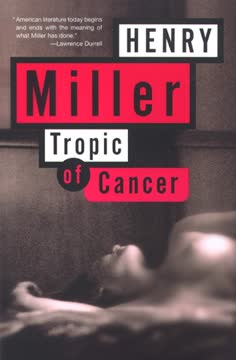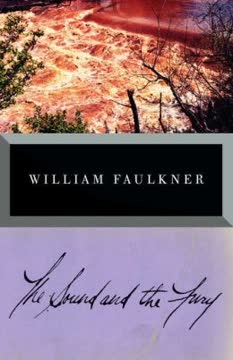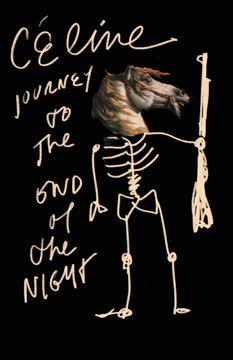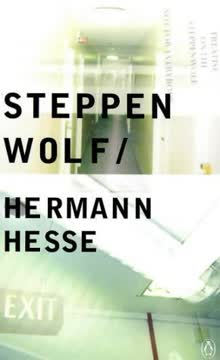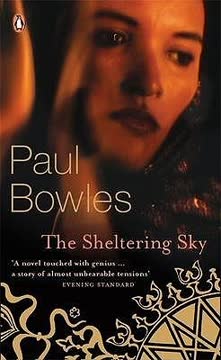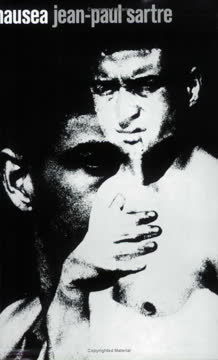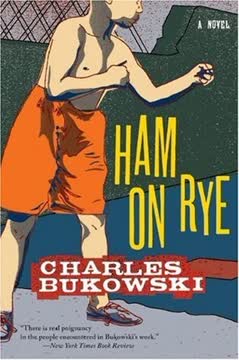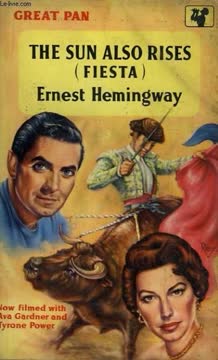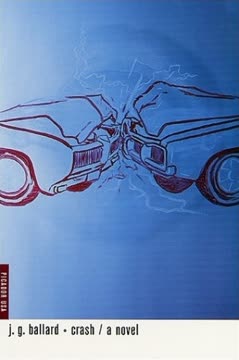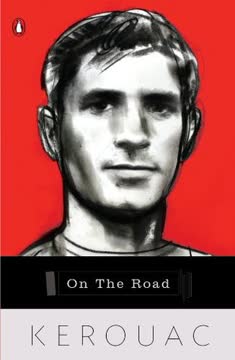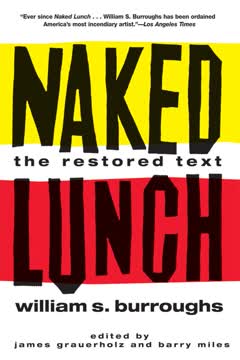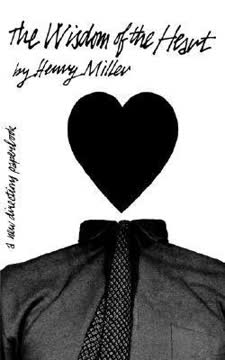Plot Summary
Paris: The Hungry Exile
Henry Miller, the narrator, arrives in Paris with nothing but his hunger, his wit, and his desire to write. He is broke, living hand-to-mouth, and yet finds a strange joy in his poverty. Paris is both a playground and a prison, a city of beauty and squalor, where every day is a struggle for food, shelter, and meaning. Miller's days are filled with wandering, observing, and surviving, as he immerses himself in the city's underbelly, meeting a cast of equally desperate expatriates and locals. The city's filth, its whores, its artists, and its endless hunger become the backdrop for his search for authenticity and selfhood.
Friends, Fools, and Failures
Miller's Paris is populated by a ragtag group of friends: Boris, the would-be writer; Van Norden, the sex-obsessed cynic; Carl, the neurotic American; and a host of others, each with their own delusions and failures. They are united by their poverty, their artistic ambitions, and their inability to fit into society. Their conversations are filled with grand ideas, petty jealousies, and endless complaints. They drink, argue, and chase women, but beneath the bravado is a deep sense of futility and alienation. Their lives are a series of comic and tragic misadventures, each one a testament to the absurdity of existence.
Tania: Love and Chaos
Tania, Miller's lover, is a force of nature—passionate, volatile, and insatiable. Their relationship is a whirlwind of sex, jealousy, and emotional violence. Tania is both muse and tormentor, embodying the chaos and ecstasy that Miller seeks in life and art. Their love is inseparable from the city's madness, and their encounters are charged with both tenderness and brutality. Through Tania, Miller explores the limits of desire, the pain of longing, and the impossibility of true connection.
The Art of Survival
Survival in Paris means hustling—scrounging for meals, cadging drinks, and relying on the generosity (or gullibility) of others. Miller becomes adept at manipulating his circumstances, whether by charming women, ingratiating himself with friends, or simply enduring hunger and discomfort. The struggle for food and shelter is ever-present, but it is also a source of dark humor and camaraderie. The city's poverty is both degrading and liberating, stripping life down to its essentials and forcing Miller to confront his own limits.
Moldorf's Anarchy
Moldorf, one of Miller's acquaintances, is a walking paradox—word-drunk, protean, and perpetually out of place. He is both clown and philosopher, a man whose mind is an amphitheater of shifting roles and ideas. Moldorf's presence is both inspiring and maddening, a reminder of the thin line between genius and madness. Through Moldorf, Miller reflects on the nature of suffering, the courage of the outsider, and the futility of seeking meaning in a world that resists understanding.
The Writer's Disease
Miller's obsession with writing is both a curse and a salvation. He is driven to document everything that is omitted from conventional literature—the filth, the violence, the rawness of life. Writing becomes a form of survival, a way to assert his existence against the void. Yet the act of creation is fraught with doubt, self-loathing, and the constant threat of failure. The "writer's disease" is a hunger that can never be satisfied, a need to transform chaos into art.
Sex, Hunger, and Laughter
The body is ever-present in Miller's world—hungry, horny, diseased, and absurd. Sex is both a compulsion and a farce, a source of pleasure and humiliation. Hunger is a constant companion, shaping every thought and action. Yet even in the midst of deprivation, there is laughter—a defiant, sometimes hysterical humor that mocks the seriousness of suffering. The grotesque becomes comic, and the comic becomes profound.
The Parisian Menagerie
Paris is a stage for a vast menagerie of characters—Jews, Russians, Americans, artists, whores, and dreamers. Each is an exile in their own way, seeking something they cannot name. The city itself is a character, both nurturing and devouring, a place where identities are fluid and boundaries are blurred. The menagerie is a microcosm of the human condition, a testament to the diversity and absurdity of life.
The American Dream, Dismantled
Miller's memories of America are tinged with bitterness and irony. The American dream—of success, progress, and meaning—has failed him, leaving only emptiness and alienation. Paris, for all its hardships, offers a kind of freedom that America cannot. The contrast between the two worlds becomes a meditation on identity, belonging, and the search for authenticity.
The Proofreader's Purgatory
Miller finds work as a proofreader, a job that is both mind-numbing and strangely liberating. Surrounded by news of disasters, wars, and scandals, he is insulated from the world's pain by the mechanical task of correcting punctuation. The proofreader's life is a metaphor for detachment, a way of surviving in a world that is always on the brink of catastrophe. The job offers a kind of immunity, a space to observe without being touched.
Women, Whorehouses, and Want
Women in Miller's Paris are everywhere—lovers, whores, muses, and tormentors. The whorehouse is both a refuge and a battleground, a place where desire is commodified and illusions are shattered. Miller's relationships with women are marked by longing, disappointment, and the constant negotiation of power and vulnerability. The pursuit of sex is inseparable from the pursuit of meaning, and both are ultimately elusive.
The Princess and the Clap
Fillmore, Miller's friend, becomes entangled with Macha, a Russian princess with a venereal disease. Their ménage à trois is a farce of misunderstandings, medical mishaps, and sexual frustration. The princess is both a figure of glamour and a source of chaos, her presence disrupting the fragile equilibrium of their lives. The episode is a microcosm of the book's themes—desire, disease, and the absurdity of human relationships.
Fillmore's French Trap
Fillmore's affair with Ginette, a Frenchwoman, spirals into disaster. What begins as a passionate romance devolves into jealousy, violence, and psychological breakdown. Fillmore is trapped by his own weakness, unable to escape Ginette's clutches or his own sense of obligation. The relationship becomes a metaphor for the dangers of illusion, the destructiveness of love, and the impossibility of escape.
The Escape Plan
As Fillmore's situation becomes untenable, Miller helps him plot an escape—fleeing Paris, abandoning Ginette, and returning to America. The plan is both comic and tragic, a last-ditch effort to reclaim autonomy. The escape is fraught with guilt, fear, and the knowledge that true freedom may be impossible. The episode underscores the book's central tension between the desire for liberation and the reality of entanglement.
The End of Illusions
With Fillmore gone and his own illusions shattered, Miller is left to confront the emptiness at the heart of his existence. The dreams of love, success, and meaning have all failed, leaving only the bare fact of survival. Yet in this emptiness, there is a strange peace—a recognition that life is what it is, and that joy can be found in the acceptance of chaos and imperfection.
The Seine's Quiet Flow
Sitting by the Seine, Miller experiences a rare moment of tranquility. The river's quiet flow becomes a symbol of acceptance, continuity, and the possibility of renewal. The city's noise and chaos recede, and for a moment, Miller feels at home in the world. The scene is a counterpoint to the book's prevailing sense of alienation, offering a glimpse of grace amid the turmoil.
The Artist's Inhuman Song
In the end, Miller embraces his role as an outsider, an "inhuman" artist who stands apart from society. Art becomes a way to transform suffering into song, to find meaning in the very act of creation. The artist is both cursed and blessed, condemned to solitude but granted the power to shape chaos into beauty. The book closes with a celebration of the artist's defiance, his refusal to be tamed by the world's expectations.
Characters
Henry Miller (The Narrator)
Miller is both the protagonist and the lens through which the story unfolds—a penniless American writer adrift in Paris, obsessed with recording the raw truth of his experience. He is at once cynical and exuberant, capable of both savage humor and deep tenderness. His relationships are marked by longing and disappointment, his friendships by camaraderie and rivalry. Psychologically, Miller is driven by a need to assert his individuality against the world's indifference, to find meaning in chaos, and to transform suffering into art. Over the course of the book, he moves from hope to disillusionment to a kind of acceptance, embracing his outsider status and the inhuman freedom of the artist.
Boris
Boris is a fellow writer and Miller's closest confidant in Paris. He is a figure of both inspiration and frustration—brilliant, erratic, and perpetually on the edge of breakdown. Boris's views on art, time, and suffering shape much of Miller's own thinking, but his inability to escape his own neuroses makes him a tragic figure. His relationship with Miller is marked by mutual dependence, rivalry, and a shared sense of exile.
Van Norden
Van Norden is a caricature of the intellectual gone to seed—a man whose life revolves around the pursuit of sex, yet who finds no satisfaction in it. He is both comic and pitiable, his bravado masking a deep sense of inadequacy and despair. His endless monologues about women, art, and his own failures provide both comic relief and a dark mirror for Miller's own anxieties.
Carl
Carl is another American expatriate, plagued by self-doubt, melancholy, and a sense of failure. He is both a friend and a rival to Miller, their relationship oscillating between camaraderie and competition. Carl's struggles with work, love, and identity reflect the broader themes of alienation and the search for meaning.
Tania
Tania is Miller's lover and muse, a woman of intense passion and volatility. She embodies both the ecstasy and the chaos that Miller seeks in life. Their relationship is marked by sexual obsession, jealousy, and emotional violence. Tania is both a source of inspiration and a symbol of the impossibility of lasting happiness.
Moldorf
Moldorf is a figure of comic absurdity and philosophical depth—a man whose identity is in constant flux, who is both clown and sage. He represents the dangers and possibilities of living outside the bounds of convention, and his presence forces Miller to confront the limits of understanding and the necessity of embracing chaos.
Fillmore
Fillmore is an American friend whose optimism and generosity are gradually eroded by his disastrous love affair with Ginette. He is both a victim and a participant in his own downfall, unable to escape the traps of love, obligation, and cultural misunderstanding. Fillmore's story is a cautionary tale about the dangers of illusion and the cost of freedom.
Ginette
Ginette is Fillmore's French lover, a woman whose love is as destructive as it is passionate. She is both victim and victimizer, her need for security and control driving Fillmore to the brink of madness. Ginette embodies the dangers of desire and the impossibility of true connection.
Macha (The Princess)
Macha is a Russian princess whose presence brings chaos and farce to Miller and Fillmore's lives. She is both glamorous and grotesque, her sense of entitlement matched only by her capacity for self-destruction. Macha's story is a parody of romance and a meditation on the absurdity of human relationships.
Elsa
Elsa is a German maid and musician who becomes one of Miller's lovers. She is a figure of sadness and longing, her life marked by disappointment and exploitation. Elsa's story highlights the vulnerability of women in Miller's world and the ways in which desire can both liberate and destroy.
Plot Devices
Fragmented, Episodic Structure
The narrative is not linear but composed of loosely connected episodes, each capturing a different facet of Miller's life in Paris. This structure mirrors the chaos and unpredictability of exile, allowing the book to move fluidly between past and present, between comic farce and existential despair. The lack of a conventional plot is itself a statement about the nature of experience and the impossibility of imposing order on chaos.
Stream-of-Consciousness and Direct Address
Miller's voice is direct, unfiltered, and often addresses the reader or his lovers (especially Tania) in the second person. This creates a sense of intimacy and urgency, drawing the reader into the narrator's inner world. The stream-of-consciousness style allows for sudden shifts in tone, subject, and perspective, reflecting the instability of the narrator's life and mind.
Sexual Explicitness and Taboo
The book's frank treatment of sex, disease, and bodily functions was revolutionary for its time, serving both as a challenge to censorship and as a means of stripping away illusion. Sex is not idealized but presented in all its messiness, absurdity, and pain. This explicitness is both a form of rebellion and a way of confronting the realities that polite society refuses to acknowledge.
Satire and Parody
Miller employs satire to deflate the pretensions of art, the illusions of love, and the hypocrisies of society. The book is filled with parodic episodes—mock-epic love affairs, farcical medical mishaps, and grotesque portraits of artists and intellectuals. This humor is both a defense against despair and a means of exposing the absurdity of human existence.
Metafiction and Self-Reflection
Miller is constantly reflecting on the act of writing itself, questioning the value of literature, the role of the artist, and the possibility of truth. The book is both a record of experience and a meditation on the impossibility of recording experience "truly." This self-consciousness is both liberating and paralyzing, a source of both insight and anxiety.
Analysis
Tropic of Cancer is not a novel in the traditional sense but a manifesto of artistic and existential defiance. Miller's Paris is a world stripped of comfort, certainty, and hope—a world of hunger, sex, disease, and failure. Yet in this very chaos, Miller finds a kind of freedom: the freedom to see, to feel, to create, and to accept life in all its ugliness and beauty. The book's explicitness, its humor, and its relentless honesty are all weapons against the deadening effects of conformity, repression, and despair. Miller's lesson is that meaning is not given but made, that art is not a refuge from life but a way of embracing it in all its messiness. In a world that is "pooped out," the only dignity left is to sing, to laugh, and to dance on the rim of the crater. Tropic of Cancer remains a powerful testament to the artist's refusal to be tamed, a celebration of the inhuman joy that comes from living and creating on one's own terms.
Last updated:
FAQ
Synopsis & Basic Details
What is Tropic of Cancer about?
- A Parisian Odyssey of Self-Discovery: Tropic of Cancer follows Henry Miller, a penniless American writer in 1930s Paris, as he navigates a life of hunger, sexual encounters, and philosophical musings. It's a raw, unfiltered account of his struggle for survival and artistic authenticity amidst a colorful cast of expatriates and locals.
- Rejection of Conventional Life: The narrative is less about a traditional plot and more about Miller's internal and external rebellion against societal norms, the American Dream, and the perceived decay of Western civilization. He embraces squalor and debauchery as pathways to a deeper, more honest understanding of existence.
- The Birth of an "Inhuman" Artist: At its core, the book chronicles Miller's transformation from a struggling individual burdened by illusions to an "inhuman" artist who finds liberation in recording life's chaos and ugliness without judgment, ultimately celebrating the raw, flowing vitality of existence.
Why should I read Tropic of Cancer?
- Unflinching Honesty and Raw Prose: Readers are drawn to Tropic of Cancer for its groundbreaking, uncensored prose that shatters literary conventions and offers an unparalleled sense of intimacy with the narrator's thoughts and experiences. It's a visceral journey into the human condition, stripped bare.
- A Landmark of Modern Literature: The novel's controversial publication and subsequent obscenity trials cemented its place as a pivotal work in literary history, challenging censorship and expanding the boundaries of what could be expressed in print. Reading it offers insight into a crucial moment in literary freedom.
- Exploration of Existential Freedom: Beyond its explicit content, the book delves into profound philosophical questions about identity, purpose, and the search for meaning in a seemingly meaningless world. Miller's defiant embrace of life's chaos resonates with those seeking liberation from societal constraints.
What is the background of Tropic of Cancer?
- Autobiographical Parisian Exile: Henry Miller wrote Tropic of Cancer based on his own experiences living as an impoverished American expatriate in Paris during the late 1920s and early 1930s. This period was marked by economic hardship and a vibrant, bohemian artistic community, which deeply influenced the book's setting and characters.
- Post-WWI European Disillusionment: The novel is steeped in the atmosphere of post-World War I Europe, reflecting a widespread sense of disillusionment, moral decay, and existential angst. Paris, while a cultural hub, is also depicted as a "charnel house" of dying traditions and lost souls, a stark contrast to the American optimism Miller critiques.
- Censorship and Obscenity Battles: Published in Paris in 1934, the book was banned in the United States for nearly three decades due to its explicit sexual content and language. Its eventual publication in the US in 1961 led to landmark obscenity trials, fundamentally reshaping American censorship laws and paving the way for greater literary freedom.
What are the most memorable quotes in Tropic of Cancer?
- "I have no money, no resources, no hopes. I am the happiest man alive.": This opening declaration immediately establishes the narrator's paradoxical state, encapsulating the book's central theme of finding joy and liberation in absolute destitution and freedom from conventional attachments. It defines his radical acceptance of his circumstances.
- "The world is a cancer eating itself away.": This recurring motif, introduced early in the novel, serves as a powerful metaphor for the pervasive decay and spiritual emptiness Miller perceives in modern society, linking the personal struggles of his characters to a broader, systemic illness. It highlights the book's dark, critical undertones.
- "I love everything that flows: rivers, sewers, lava, semen, blood, bile, words, sentences.": Towards the end, this ecstatic affirmation reveals Miller's ultimate artistic and philosophical stance, embracing all aspects of life—the beautiful and the grotesque—as part of a continuous, vital current, signifying his complete surrender to and celebration of existence.
What writing style, narrative choices, and literary techniques does Henry Miller use?
- Unfiltered, Confessional First-Person: Miller employs a highly personal, stream-of-consciousness narration, often directly addressing the reader or specific characters, creating an illusion of raw, unmediated thought and experience. This technique blurs the line between author and narrator, enhancing the book's autobiographical feel.
- Juxtaposition of High and Low Culture: The prose frequently shifts between lyrical, philosophical meditations on art, literature, and the cosmos, and graphic, vulgar descriptions of bodily functions, sex, and urban squalor. This stylistic contrast underscores the book's rejection of artificial distinctions and its embrace of life's full spectrum.
- Cyclical and Associative Structure: Rather than a linear plot, the narrative unfolds through a series of vignettes, memories, and digressions, often returning to recurring motifs and themes. This non-chronological, associative flow mirrors the chaotic, dream-like quality of the narrator's Parisian existence and his internal world.
Hidden Details & Subtle Connections
What are some minor details that add significant meaning?
- The Recurring Image of Lice: The opening scene with Boris discovering he is "lousy" and the later descriptions of people "scratching and scratching until the blood comes" (p. 1, 10) are not just literal observations of squalor. They symbolize the pervasive sense of infestation, decay, and inescapable misery that clings to the characters and the city itself, suggesting a deeper spiritual or societal affliction.
- The "Rubber Plant" Motif: The rubber plant, first appearing in Moldorf's description as a "Vase without a rubber plant" (p. 3) and later carried by Sylvester (p. 11), subtly represents artificiality, sterility, and the futile attempts to cultivate life or art in a decaying environment. It contrasts with Miller's desire for organic, flowing vitality.
- The "Dirty Sock" of Hidden Money: The miserly fairy's "money hidden away in a sock" (p. 9) is a small detail that highlights the desperate, often undignified, measures characters take to hoard resources in a world of scarcity. It contrasts sharply with Miller's own open-handed, if often penniless, approach to life, emphasizing different philosophies of survival.
What are some subtle foreshadowing and callbacks?
- Boris's "Cancer of Time" Prophecy: Early in the book, Boris declares, "The cancer of time is eating us away" (p. 1), a phrase that foreshadows the pervasive sense of decay and futility that permeates the narrative. This idea is echoed in Miller's later description of Paris as a "cancer eating itself away" (p. 2) and his own Paris growing "inside you like a cancer" (p. 30), linking personal and cosmic dissolution.
- The "Man Cut in Slices" Title: Miller's fascination with the fictional book title "A Man Cut in Slices!" (p. 15) foreshadows his own later artistic ambition to dissect and expose human experience in its rawest form, without sentimentality. It's a meta-commentary on his narrative approach, aiming for a brutal, fragmented truth.
- Mona's Enigmatic Smile: Mona's "sad, inscrutable smile" (p. 30) when leaving Miller, and her earlier "disapproving eye" (p. 7), are callbacks to a past relationship that continues to haunt the narrator. This recurring image suggests an unresolved emotional core and the enduring impact of lost love, even as Miller claims to be free of the past.
What are some unexpected character connections?
- Miller's Empathy for Kruger: Despite Kruger being a "rotten painter" and "anal type" (p. 37), Miller develops an unexpected bond with him, even allowing Kruger to care for him when he's ill. This connection reveals Miller's capacity for compassion beyond his usual cynical observations, highlighting a shared vulnerability among struggling artists.
- The Shared "Joe" Identity: The narrator and Carl both refer to Van Norden as "Joe," and the narrator himself is sometimes called "Joe" (p. 22). This seemingly trivial detail subtly blurs individual identities, suggesting a collective, almost interchangeable, experience of male expatriate life in Paris, where personal distinctions often dissolve in shared struggles and vices.
- The Concierge's Unseen Influence: The concierge, often a minor background figure, is repeatedly mentioned as a recipient of stale bread from Nanantatee (p. 26) and a source of borrowed items. This highlights her quiet, almost invisible, role in the survival network of the impoverished artists, a subtle nod to the hidden support systems in the Parisian underbelly.
Who are the most significant supporting characters?
- Collins, the World-Weary Sailor: Collins, though appearing briefly, is significant as a foil to Miller's intellectualism, embodying a raw, unpretentious vitality and a pragmatic approach to life's hardships. His humorous tales of disease and travel, like his Yangtze Kiang story (p. 39), offer a different kind of wisdom and resilience, suggesting that true experience often lies outside the realm of books.
- The Night Watchman (Veilleur de Nuit): This "nobody" figure at the Dijon penitentiary (p. 47) becomes a profound symbol of quiet endurance and the acceptance of one's lot. His ritualistic drinking of wine, described as "pouring rubies down his gullet," and his "desperate, hopeless smile" (p. 48) resonate with Miller's own search for meaning in a world devoid of grand narratives, representing a stoic, almost spiritual, resignation.
- Matisse, the Unseen Artistic Ideal: Henri Matisse, though never physically present, is a crucial artistic touchstone for Miller, representing an ideal of creation that transcends the "ugly scaffold" of reality (p. 34). His art, described as "a world so natural, so complete," offers a vision of transforming "negative reality... into the substantial and significant outlines of art," serving as a guiding light for Miller's own artistic philosophy.
Psychological, Emotional, & Relational Analysis
What are some unspoken motivations of the characters?
- Boris's Fear of Irrelevance: Beneath Boris's intellectual pronouncements and philosophical discussions about "the cancer of time" (p. 1), there's an unspoken fear of being forgotten or becoming irrelevant, especially in the face of Miller's raw, uninhibited approach to life and writing. His desire for Miller to "live more vitally every day, as I am dead" (p. 40) suggests a vicarious longing for a life he feels incapable of living himself.
- Van Norden's Quest for Annihilation: While Van Norden explicitly states his desire for "a bunch of books, a bunch of dreams, and a bunch of cunt" (p. 23), his deeper, unspoken motivation is a desperate attempt to escape his own self-loathing and the "prison which he has created for himself" (p. 24). His relentless pursuit of sex and his "obliteration" during orgasm are attempts at temporary self-annihilation, a fleeting escape from his conscious torment.
- Tania's Need for Validation: Tania's passionate, often volatile behavior, and her insistence on playing the "adagio" (p. 11) repeatedly, hint at an unspoken need for intense emotional and artistic validation. Her declaration "I love him!" (p. 3) and her later sentimentality with Miller suggest a craving for a love that transcends the transactional nature of her relationships, seeking a depth that her chaotic life often denies.
What psychological complexities do the characters exhibit?
- Miller's Detached Engagement: The narrator exhibits a complex psychological state of being both deeply immersed in and profoundly detached from the squalor and drama around him. He describes himself as "a sentient being stabbed by the miracle of these waters" (p. 4) yet also capable of "murderous, silent contempt" (p. 28) for others' suffering, showcasing a unique blend of sensitivity and cold observation.
- Fillmore's Moral Erosion: Fillmore's journey reveals a psychological erosion from naive optimism to a state of utter helplessness and moral compromise. His initial generosity and "Yankee blood" (p. 43) give way to a cowering, cringing demeanor under Ginette's influence, illustrating how external pressures can dismantle one's core identity and values.
- Macha's Delusional Grandeur: The Princess Macha embodies a complex mix of past grandeur and present delusion, clinging to her aristocratic identity while living in squalor and suffering from venereal disease. Her theatricality and self-deception, such as her claim of being a "great actress" (p. 44) and her fabricated suicide attempt, highlight a psychological defense mechanism against a harsh reality she cannot fully confront.
What are the major emotional turning points?
- The Lice Infestation with Mona: The discovery of lice on Mona's hair (p. 8) after a period of intense intimacy marks a significant emotional turning point, shattering the romantic illusion of their reunion. This grotesque detail forces Miller to confront the raw, unglamorous reality of their shared existence and the pervasive decay that underlies even moments of tenderness.
- Fillmore's Breakdown and Escape: Fillmore's emotional collapse, culminating in his institutionalization and subsequent desperate escape from Ginette (p. 49-52), serves as a major turning point, illustrating the destructive power of toxic relationships and the profound psychological toll of entrapment. It forces Miller to actively intervene, moving beyond passive observation.
- Miller's Embrace of "Inhumanity": The narrator's declaration, "Today I am proud to say that I am inhuman, that I belong not to men and governments" (p. 55), marks a profound emotional and philosophical shift. This is not a moment of despair but one of liberation, where he sheds the constraints of conventional humanity to fully embrace his role as an artist who transmutes chaos into a "contaminating" song.
How do relationship dynamics evolve?
- From Mutual Dependence to Exploitation: Many relationships, like Miller's with his various hosts for meals (p. 12), begin with a semblance of mutual benefit or camaraderie but often devolve into subtle or overt exploitation. Miller, while often the beneficiary, is also a keen observer of these power imbalances, noting how "they were all obviously relieved when they realized that they would see me only once a week."
- The Shifting Sands of Love and Hatred: Relationships, particularly romantic ones, are depicted as highly volatile, oscillating rapidly between intense passion and bitter animosity. Tania's declaration "I love him!" (p. 3) is quickly followed by Miller's violent sexual fantasies about her and Sylvester, illustrating the thin line between adoration and resentment, and the destructive potential within intimacy.
- Friendship as a Mirror and a Burden: Friendships, such as those with Carl and Van Norden, evolve from shared struggles and intellectual camaraderie into complex dynamics of mirroring and mutual burden. Carl's "melancholy breath" (p. 17) wounds Miller, while Van Norden's monologues become a "duet" where each waits for "the signal which announces the advent of one's own voice" (p. 28), highlighting both connection and profound self-absorption.
Interpretation & Debate
Which parts of the story remain ambiguous or open-ended?
- The Nature of Miller's "Happiness": Despite his repeated claims of being "the happiest man alive" (p. 1) amidst squalor and despair, the true nature of this happiness remains ambiguous. Is it genuine existential liberation, a psychological defense mechanism, or a performative stance for his artistic persona? The text allows for multiple interpretations, inviting readers to question the authenticity of his proclaimed joy.
- The Reality of Narrated Events: Given Miller's highly subjective, stream-of-consciousness style and his self-proclaimed role as a "liar" (p. 55), the precise factual accuracy of many events, particularly the more outrageous sexual encounters or the detailed conversations, is left open to interpretation. Readers must decide how much of the narrative is literal truth versus artistic embellishment or psychological projection.
- The Fate of Mona: Mona, a central figure in Miller's past, is mentioned as having left him and later appears in a cablegram that never materializes (p. 32). Her ultimate fate and the true reasons for her departure remain largely unresolved, contributing to the book's sense of lingering loss and the narrator's inability to fully reconcile with his past relationships.
What are some debatable, controversial scenes or moments in Tropic of Cancer?
- The "Man Cut in Slices" Fantasy and Infanticide: Miller's extended fantasy about the book "A Man Cut in Slices!" (p. 15), culminating in the chilling line "I suddenly went home and chopped the baby to pieces," is highly controversial. It sparks debate about the narrator's psychological state, the boundaries of artistic expression, and whether it represents a literal dark impulse or a metaphorical act of destroying innocence and conventional narratives.
- The Treatment of Women as "Cunts": The pervasive and often dehumanizing language used to describe women, frequently reducing them to their sexual organs (e.g., "cunt-struck," "my Georgia cunt"), is a major point of contention. This raises questions about misogyny, the objectification of women, and whether Miller's portrayal is a reflection of his era, a deliberate provocation, or an attempt to strip away romanticized illusions about sex.
- The "Inhuman" Artist Declaration: Miller's final embrace of an "inhuman" identity (p. 55), rejecting traditional morality and human connection for the sake of art, is deeply debatable. Some interpret it as a profound statement of artistic freedom and transcendence, while others view it as a nihilistic or solipsistic retreat from responsibility and empathy.
Tropic of Cancer Ending Explained: How It Ends & What It Means
- A Return to Primal Flow: The book concludes with Miller's ecstatic embrace of "everything that flows" (p. 56)—rivers, sewers, semen, blood, words—signifying a complete surrender to the chaotic, vital currents of existence. This is not a resolution in a conventional sense, but an acceptance of life's inherent messiness and a rejection of static ideals.
- The Artist's Defiant Rebirth: Miller declares himself "inhuman" (p. 55), shedding the constraints of conventional morality and identity to become a pure conduit for artistic expression. The ending portrays him as a "clown" and a "dancing seer" who transmutes the "dead compost" of humanity into a "song that contaminates" (p. 55), asserting the artist's role as an outsider who creates order from chaos.
- Perpetual Motion Towards the Unknown: The final lines, "Through endless night the earth whirls toward a creation unknown" (p. 56), emphasize a cyclical, ongoing process of destruction and creation, mirroring the book's fragmented structure and its rejection of definitive endings. It suggests that true meaning lies not in arrival but in the continuous, often violent, journey of becoming, leaving the reader with a sense of boundless, albeit unsettling, possibility.
Review Summary
Tropic of Cancer is a controversial and polarizing novel. Many praise Miller's raw, poetic prose and unflinching portrayal of 1930s Paris, viewing it as a masterpiece of 20th-century literature. Others criticize its graphic sexual content, misogyny, and lack of traditional plot. The stream-of-consciousness style and philosophical musings resonate with some readers, while others find it self-indulgent and difficult to follow. Despite its divisive nature, the book is widely recognized for its literary significance and role in challenging censorship.
Tropic Series
Similar Books
Download PDF
Download EPUB
.epub digital book format is ideal for reading ebooks on phones, tablets, and e-readers.
